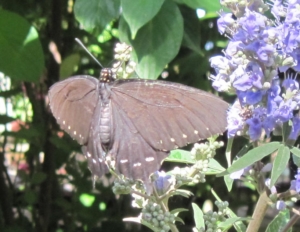
Butterflies as Pollinators
Photograph by Nancy E. Rogers
The Gardens
Savannah and Ruwena began their tour by walking through the flower gardens on both sides of the manor house. Master Ferronas (fer-ōn-as), the master gardener, pointed out, “Many of these flowers attract pollinators – bees, butterflies, hummingbirds, and even moths – which we need to pollinate the vegetable and herb gardens.”
In the vegetable gardens, Ruwena saw root vegetables such as potatoes, carrots, and onions; legumes such as beans and peas; green leafy vegetables such as spinach and collard greens; and many other food plants. “Many vegetables are the source of essential nutrients we all need to be heathy,” said Master Ferronas. “Some of these nutrients even influence the function of our genes.”
(Excerpt from Homo transformans: The Origin and Nature of the Species)
The Role of Pollinators in Nutrition
Approximately 35% of food crops are dependent upon cross pollination by insects. Bees are the insect most often recognized as pollinators. Yet, there are many other insects that pollinate plants. These include butterflies, moths, wasps, ants, and beetles. In addition birds (e.g., hummingbirds) and bats also pollinate plants (Rader, et al., 2016.)
Vitamins are essential physiologic agents that are not produced by the body. Hence, we are reliant upon external sources of these agents. Plants provide the majority of essential vitamins, and these plants are dependent upon pollinators (Rader, et al., 2016.)
Vitamin A
Vitamin A is an essential nutrient required to maintain the integrity of tissues in most organs, and is required for maintaining vision in low light settings (Gilbert, 2013). Plant sources of vitamin A include orange/red vegetables (e.g., squash, carrots, sweet potatoes, pumpkin) and dark green leafy vegetables (e.g., spinach). Bees and flies pollinate these plants.
Vitamin B
The B vitamins include B1 (thiamine), B2 (riboflavin), B3 (niacin), B9 (folate), B12, and others. These vitamins are key agents in metabolism (Kennedy, 2016). They serve as co-enzymes in a vast array enzymatic reactions for the production of energy (catabolism), in building and maintain tissues (anabolism), and in affecting the activity of genes (methylation). Two of them – B12 and folate – play a major role in the development and function of the nervous system and in the methylation of genes, which modifies their functions and also turn them off (Selhub, 2002).
With the exception of B12, all of the other B vitamins are derived from plant sources: grains, legumes, nuts, seeds, and leafy green vegetables. Meat, eggs, and milk products are sources of B12.
Bees are the primary pollinators for legumes. Bees also pollinate nut trees that are not self-pollinating. Grains are pollinated by the wind.
Vitamin C
Vitamin C (ascorbic acid) is a potent antioxidant that supports the development and maintenance of the nervous system (Figueroa-Méndez & Rivas-Arancibia, 2015), the vascular system (Oudemans-van Straaten, et al., 2014), and the immune system (Carr & Maggini, 2017). It also has a role in regulating the genes that affect the development of immune cells which, in turn, prevent or fight infections.
Citrus fruits and fruit juices are among the highest sources of vitamin C. Other fruit sources include berries (e.g., strawberries, blue berries, etc.), and additional fruits. Vegetable sources of vitamin C include broccoli, leafy green vegetables (e.g., spinach), cauliflower, and tomatoes.
Bees are the primary pollinators for fruit trees.
Vitamin D
Vitamin D is essential for the absorption of calcium from the gastrointestinal tract and, consequently, for the development of bones. It is the only vitamin that people can make provided their skin has adequate exposure to sunlight (ultraviolet radiation) (Nair & Maseeh, 2012). The form of vitamin D made by the skin (D2) must be converted to the active form (D3) by the liver.
Food sources of vitamin D include fish (salmon, tuna, mackerel, etc.) Other sources include mushrooms and commercial food products fortified with vitamin D (e.g., milk).
Mushrooms are pollinated by fungus gnats that feed on decaying matter in the soil.
References
Carr, A. C., and Maggini, S. (2017). Vitamin C and Immune Function. Nutrients, 9(11), 1211. doi:10.3390/nu9111211.
Figueroa-Méndez, R., & Rivas-Arancibia, S. (2015.) Vitamin C in Health and Disease: Its Role in the Metabolism of Cells and Redox State in the Brain. Frontiers in Physiology, 6, 397. doi:10.3389/fphys.2015.00397
Gilbert C. (2013.) What is vitamin A and why do we need it?. Community Eye Health, 26(84), 65.
Kennedy D. O. (2016). B Vitamins and the Brain: Mechanisms, Dose and Efficacy–A Review. Nutrients, 8(2), 68. doi:10.3390/nu8020068.
Nair, R., and Maseeh, A. (2012.) Vitamin D: The “sunshine” vitamin. Journal of Pharmacology & Pharmacotherapeutics, 3(2), 118–126. doi:10.4103/0976-500X.95506.
Oudemans-van Straaten, H. M., Spoelstra-de Man, A. M., and de Waard, M. C. (2014). Vitamin C revisited. Critical care (London, England), 18(4), 460. doi:10.1186/s13054-014-0460-x.
Rader, R., Bartomeus, I., Garibaldi, L. A., et al. (2016.) Non-bee insect crop pollination. Proceed Natl Acad Sci., 113(1), 146-151. doi: 10.1073/pnas.1517092112.
Selhub, J. (2002.) Folate, vitamin B12 and vitamin B6 and one carbon metabolism. J Nutr Health Aging, 6(1), 39-42.